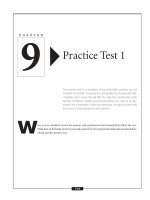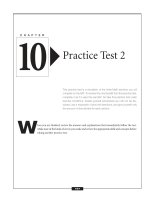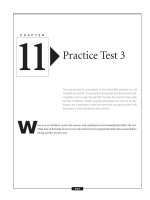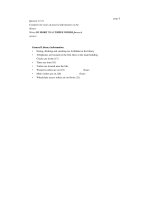SAT math essentials part 7 ppt
Bạn đang xem bản rút gọn của tài liệu. Xem và tải ngay bản đầy đủ của tài liệu tại đây (344.94 KB, 20 trang )
Practice Question
What is the length of c in the triangle above?
a. 30
b. 40
c. 60
d. 80
e. 100
Answer
d. You could use the Pythagorean theorem to solve this question, but if you notice that the triangle shows
two parts of a Pythagorean triple, you don’t have to. 60:c:100 is a multiple of 6:8:10 (which is a multiple
of 3:4:5). Therefore, c must equal 80 because 60:80:100 is the same ratio as 6:8:10.
45-45-90 Right Triangles
An isosceles right triangle is a right triangle with two angles each measuring 45°.
Special rules apply to isosceles right triangles:
■
the length of the hypotenuse ϭ ͙2
ෆ
ϫ the length of a leg of the triangle
45°
45°
x
x
xΊ2
45°
45°
60 100
c
–GEOMETRY REVIEW–
115
■
the length of each leg is ϫ the length of the hypotenuse
You can use these special rules to solve problems involving isosceles right triangles.
Example
In the isosceles right triangle below, what is the length of a leg, x?
x ϭϫthe length of the hypotenuse
x ϭϫ28
x ϭ
x ϭ 14͙2
ෆ
28͙2
ෆ
ᎏ
2
͙2
ෆ
ᎏ
2
͙2
ෆ
ᎏ
2
28
x
x
45°
45°
c
cΊ2
2
cΊ2
2
͙2
ෆ
ᎏ
2
–GEOMETRY REVIEW–
116
Practice Question
What is the length of a in the triangle above?
a.
b.
c. 15͙2
ෆ
d. 30
e. 30͙2
ෆ
Answer
c. In an isosceles right triangle, the length of the hypotenuse ϭ ͙2
ෆ
ϫ the length of a leg of the triangle.
According to the figure, one leg ϭ 15. Therefore, the hypotenuse is 15͙2
ෆ
.
30-60-90 Triangles
Special rules apply to right triangles with one angle measuring 30° and another angle measuring 60°.
■
the hypotenuse ϭ 2 ϫ the length of the leg opposite the 30° angle
■
the leg opposite the 30° angle ϭ
ᎏ
1
2
ᎏ
ϫ the length of the hypotenuse
■
the leg opposite the 60° angle ϭ ͙3
ෆ
ϫ the length of the other leg
You can use these rules to solve problems involving 30-60-90 triangles.
60°
30°
2s
s
Ί3 s
15͙2
ෆ
ᎏ
2
15͙2
ෆ
ᎏ
4
45°
15
15
45°
a
–GEOMETRY REVIEW–
117
Example
What are the lengths of x and y in the triangle below?
The hypotenuse ϭ 2 ϫ the length of the leg opposite the 30° angle. Therefore, you can write an equation:
y ϭ 2 ϫ 12
y ϭ 24
The leg opposite the 60° angle ϭ ͙3
ෆ
ϫ the length of the other leg. Therefore, you can write an equation:
x ϭ 12͙3
ෆ
Practice Question
What is the length of y in the triangle above?
a. 11
b. 11͙2
ෆ
c. 11͙3
ෆ
d. 22͙2
ෆ
e. 22͙3
ෆ
Answer
c. In a 30-60-90 triangle, the leg opposite the 30° angle ϭ half the length of the hypotenuse. The
hypotenuse is 22, so the leg opposite the 30° angle ϭ 11. The leg opposite the 60° angle ϭ ͙3
ෆ
ϫ the
length of the other leg. The other leg ϭ 11, so the leg opposite the 60° angle ϭ 11͙3
ෆ
.
60°
22
30°
x
y
60°
12
30°
y
x
–GEOMETRY REVIEW–
118
Triangle Trigonometry
There are special ratios we can use when working with right triangles. They are based on the trigonometric func-
tions called sine, cosine, and tangent.
For an angle, ⌰, within a right triangle, we can use these formulas:
sin ⌰ϭ
ᎏ
hy
o
p
p
o
p
t
o
e
s
n
i
u
te
se
ᎏ
cos ⌰ϭ
ᎏ
hy
a
p
d
o
ja
t
c
e
e
n
n
u
t
se
ᎏ
tan ⌰ϭ
ᎏ
o
ad
p
j
p
a
o
c
s
e
i
n
te
t
ᎏ
The popular mnemonic to use to remember these formulas is SOH CAH TOA.
SOH stands for Sin: Opposite/Hypotenuse
CAH stands for Cos: Adjacent/Hypotenuse
TOA stands for Tan: Opposite/Adjacent
Although trigonometry is tested on the SAT, all SAT trigonometry questions can also be solved using geom-
etry (such as rules of 45-45-90 and 30-60-90 triangles), so knowledge of trigonometry is not essential. But if you
don’t bother learning trigonometry, be sure you understand triangle geometry completely.
opposite
hypotenuse
adjacent
hypotenuse
opposite
adjacent
To find sin ⌰
To find cos ⌰ To find tan ⌰
⌰
⌰
⌰
–GEOMETRY REVIEW–
119
TRIG VALUES OF SOME COMMON ANGLES
SIN COS TAN
30°
ᎏ
1
2
ᎏ
45° 1
60°
ᎏ
1
2
ᎏ
͙3
ෆ
͙3
ෆ
ᎏ
2
͙2
ෆ
ᎏ
2
͙2
ෆ
ᎏ
2
͙3
ෆ
ᎏ
3
͙3
ෆ
ᎏ
2
Example
First, let’s solve using trigonometry:
We know that cos 45° ϭ , so we can write an equation:
ᎏ
hy
a
p
d
o
ja
t
c
e
e
n
n
u
t
se
ᎏ
ϭ
ᎏ
1
x
0
ᎏ
ϭ Find cross products.
2 ϫ 10 ϭ x͙2
ෆ
Simplify.
20 ϭ x͙2
ෆ
ϭ x
Now, multiply by (which equals 1), to remove the ͙2
ෆ
from the denominator.
ϫϭx
ϭ x
10͙2
ෆ
ϭ x
Now let’s solve using rules of 45-45-90 triangles, which is a lot simpler:
The length of the hypotenuse ϭ ͙2
ෆ
ϫ the length of a leg of the triangle. Therefore, because the leg is 10, the
hypotenuse is ͙2
ෆ
ϫ 10 ϭ 10͙2
ෆ
.
20͙2
ෆ
ᎏ
2
20
ᎏ
͙2
ෆ
͙2
ෆ
ᎏ
͙2
ෆ
͙2
ෆ
ᎏ
͙2
ෆ
20
ᎏ
͙2
ෆ
20
ᎏ
͙2
ෆ
͙2
ෆ
ᎏ
2
͙2
ෆ
ᎏ
2
͙2
ෆ
ᎏ
2
45°
x
10
–GEOMETRY REVIEW–
120
Circles
A circle is a closed figure in which each point of the circle is the same distance from the center of the circle.
Angles and Arcs of a Circle
■
An arc is a curved section of a circle.
■
A minor arc is an arc less than or equal to 180°. A major arc is an arc greater than or equal to 180°.
■
A central angle of a circle is an angle with its vertex at the center and sides that are radii. Arcs have the same
degree measure as the central angle whose sides meet the circle at the two ends of the arc.
Central Angle
Major Arc
Minor Arc
–GEOMETRY REVIEW–
121
Length of an Arc
To find the length of an arc, multiply the circumference of the circle, 2πr,where r ϭ the radius of the circle, by
the fraction
ᎏ
36
x
0
ᎏ
, with x being the degree measure of the central angle:
2πr ϫ
ᎏ
36
x
0
ᎏ
ϭ
ᎏ
2
3
π
6
r
0
x
ᎏ
ϭ
ᎏ
1
π
8
rx
0
ᎏ
Example
Find the length of the arc if x ϭ 90 and r ϭ 56.
L ϭ
ᎏ
1
π
8
rx
0
ᎏ
L ϭ
ᎏ
π(5
1
6
8
)
0
(90)
ᎏ
L ϭ
ᎏ
π(
2
56)
ᎏ
L ϭ 28π
The length of the arc is 28π.
Practice Question
If x ϭ 32 and r ϭ 18, what is the length of the arc shown in the figure above?
a.
ᎏ
16
5
π
ᎏ
b.
ᎏ
32
5
π
ᎏ
c. 36π
d.
ᎏ
28
5
8π
ᎏ
e. 576π
x°
r
r
r
x°
–GEOMETRY REVIEW–
122
Answer
a. To find the length of an arc, use the formula
ᎏ
1
π
8
rx
0
ᎏ
,where r ϭ the radius of the circle and x ϭ the meas-
ure of the central angle of the arc. In this case, r ϭ 18 and x ϭ 32.
ᎏ
1
π
8
rx
0
ᎏ
ϭ
ᎏ
π(1
1
8
8
)
0
(32)
ᎏ
ϭ
ᎏ
π
1
(3
0
2)
ᎏ
ϭ
ᎏ
π (
5
16)
ᎏ
ϭ
ᎏ
16
5
π
ᎏ
Area of a Sector
A sector of a circle is a slice of a circle formed by two radii and an arc.
To find the area of a sector, multiply the area of a circle, πr
2
, by the fraction
ᎏ
36
x
0
ᎏ
, with x being the degree meas-
ure of the central angle:
ᎏ
π
3
r
6
2
0
x
ᎏ
.
Example
Given x ϭ 120 and r ϭ 9, find the area of the sector:
A ϭ
ᎏ
π
3
r
6
2
0
x
ᎏ
A ϭ
ᎏ
π(9
2
3
)
6
(
0
120)
ᎏ
A ϭ
ᎏ
π(
3
9
2
)
ᎏ
A ϭ
ᎏ
81
3
π
ᎏ
A ϭ 27π
The area of the sector is 27π.
x°
r
r
secto
r
–GEOMETRY REVIEW–
123
Practice Question
What is the area of the sector shown above?
a.
ᎏ
4
3
9
6
π
0
ᎏ
b.
ᎏ
7
3
π
ᎏ
c.
ᎏ
49
3
π
ᎏ
d. 280π
e. 5,880π
Answer
c. To find the area of a sector, use the formula
ᎏ
π
3
r
6
2
0
x
ᎏ
,where r ϭ the radius of the circle and x ϭ the measure
of the central angle of the arc. In this case, r ϭ 7 and x ϭ 120.
ᎏ
π
3
r
6
2
0
x
ᎏ
ϭ
ᎏ
π(7
2
3
)
6
(
0
120)
ᎏ
ϭ
ᎏ
π(49
3
)
6
(
0
120)
ᎏ
ϭ
ᎏ
π(
3
49)
ᎏ
ϭ
ᎏ
49
3
π
ᎏ
Tangents
A tangent is a line that intersects a circle at one point only.
tangent
point of intersection
120°
7
–GEOMETRY REVIEW–
124
There are two rules related to tangents:
1. A radius whose endpoint is on the tangent is always perpendicular to the tangent line.
2. Any point outside a circle can extend exactly two tangent lines to the circle. The distances from the origin
of the tangents to the points where the tangents intersect with the circle are equal.
Practice Question
What is the length of A
ෆ
B
ෆ
in the figure above if B
ෆ
C
ෆ
is the radius of the circle and A
ෆ
B
ෆ
is tangent to the circle?
a. 3
b. 3͙2
ෆ
c. 6͙2
ෆ
d. 6͙3
ෆ
e. 12
A
B
6
30°
C
AB = AC
—
—
B
C
A
–GEOMETRY REVIEW–
125
Answer
d. This problem requires knowledge of several rules of geometry. A tangent intersects with the radius of a
circle at 90°. Therefore, ΔABC is a right triangle. Because one angle is 90° and another angle is 30°,
then the third angle must be 60°. The triangle is therefore a 30-60-90 triangle.
In a 30-60-90 triangle, the leg opposite the 60° angle is ͙3
ෆ
ϫ the leg opposite the 30° angle. In
this figure, the leg opposite the 30° angle is 6, so A
ෆ
B
ෆ
, which is the leg opposite the 60° angle, must be
6͙3
ෆ
.
Polygons
A polygon is a closed figure with three or more sides.
Example
Terms Related to Polygons
■
A regular (or equilateral) polygon has sides that are all equal; an equiangular polygon has angles that are all
equal. The triangle below is a regular and equiangular polygon:
■
Vertices are corner points of a polygon. The vertices in the six-sided polygon below are: A, B, C, D, E, and F.
B
CF
A
DE
–GEOMETRY REVIEW–
126
■
A diagonal of a polygon is a line segment between two non-adjacent vertices. The diagonals in the polygon
below are line segments A
ෆ
C
ෆ
, A
ෆ
D
ෆ
, A
ෆ
E
ෆ
, B
ෆ
D
ෆ
, B
ෆ
E
ෆ
, B
ෆ
F
ෆ
, C
ෆ
E
ෆ
, C
ෆ
F
ෆ
, and D
ෆ
F
ෆ
.
Quadrilaterals
A quadrilateral is a four-sided polygon. Any quadrilateral can be divided by a diagonal into two triangles, which
means the sum of a quadrilateral’s angles is 180° ϩ 180° ϭ 360°.
Sums of Interior and Exterior Angles
To find the sum of the interior angles of any polygon, use the following formula:
S ϭ 180(x Ϫ 2), with x being the number of sides in the polygon.
Example
Find the sum of the angles in the six-sided polygon below:
S ϭ 180(x Ϫ 2)
S ϭ 180(6 Ϫ 2)
S ϭ 180(4)
S ϭ 720
The sum of the angles in the polygon is 720°.
12
4
3
m∠1 + m∠2 + m∠3 + m∠4 = 360°
B
CF
A
D
E
–GEOMETRY REVIEW–
127
Practice Question
What is the sum of the interior angles in the figure above?
a. 360°
b. 540°
c. 900°
d. 1,080°
e. 1,260°
Answer
d. To find the sum of the interior angles of a polygon, use the formula S ϭ 180(x Ϫ 2), with x being the
number of sides in the polygon. The polygon above has eight sides, therefore x ϭ 8.
S ϭ 180(x Ϫ 2) ϭ 180(8 Ϫ 2) ϭ 180(6) ϭ 1,080°
Exterior Angles
The sum of the exterior angles of any polygon (triangles, quadrilaterals, pentagons, hexagons, etc.) is 360°.
Similar Polygons
If two polygons are similar, their corresponding angles are equal, and the ratio of the corresponding sides is in
proportion.
Example
These two polygons are similar because their angles are equal and the ratio of the corresponding sides is in
proportion:
ᎏ
2
1
0
0
ᎏ
ϭ
ᎏ
2
1
ᎏ
ᎏ
1
9
8
ᎏ
ϭ
ᎏ
2
1
ᎏᎏ
8
4
ᎏ
ϭ
ᎏ
2
1
ᎏ
ᎏ
3
1
0
5
ᎏ
ϭ
ᎏ
2
1
ᎏ
18
30
20
135°
75°
135°
75°
60°
9
15
10
60°
8
4
–GEOMETRY REVIEW–
128
Practice Question
If the two polygons above are similar, what is the value of d?
a. 2
b. 5
c. 7
d. 12
e. 23
Answer
a. The two polygons are similar, which means the ratio of the corresponding sides are in proportion.
Therefore, if the ratio of one side is 30:5, then the ration of the other side, 12:d, must be the same.
Solve for d using proportions:
ᎏ
3
5
0
ᎏ
ϭ
ᎏ
1
d
2
ᎏ
Find cross products.
30d ϭ (5)(12)
30d ϭ 60
d ϭ
ᎏ
6
3
0
0
ᎏ
d ϭ 2
Parallelograms
A parallelogram is a quadrilateral with two pairs of parallel sides.
In the figure above, A
ෆ
B
ෆ
|| D
ෆ
C
ෆ
and A
ෆ
D
ෆ
|| B
ෆ
C
ෆ
.
Parallelograms have the following attributes:
■
opposite sides that are equal
A
ෆ
D
ෆ
ϭ B
ෆ
C
ෆ
A
ෆ
B
ෆ
ϭ D
ෆ
C
ෆ
■
opposite angles that are equal
m∠A ϭ m∠C m∠B ϭ m∠D
■
consecutive angles that are supplementary
m∠A ϩ m∠B ϭ 180° m∠B ϩ m∠C ϭ 180°
m∠C ϩ m∠D ϭ 180° m∠D ϩ m∠A ϭ 180°
AB
DC
30
12
5
d
–GEOMETRY REVIEW–
129
Special Types of Parallelograms
■
A rectangle is a parallelogram with four right angles.
■
A rhombus is a parallelogram with four equal sides.
■
A square is a parallelogram with four equal sides and four right angles.
Diagonals
■
A diagonal cuts a parallelogram into two equal halves.
B
A
CD
᭝ABC = ᭝ADC
BA
CD
AB = BC = DC = AD
m∠A = m∠B = m∠C = m∠D = 90
BA
CD
AB = BC = DC = AD
A
D
AD = BC AB = DC
–GEOMETRY REVIEW–
130
■
In all parallelograms, diagonals cut each other into two equal halves.
■
In a rectangle, diagonals are the same length.
■
In a rhombus, diagonals intersect at right angles.
■
In a square, diagonals are the same length and intersect at right angles.
B
A
CD
AC = DB
AC DB
BA
CD
AC DB
BA
CD
AC = DB
BA
E
C
D
AE = CE
DE = BE
–GEOMETRY REVIEW–
131
Practice Question
Which of the following must be true about the square above?
I. a ϭ b
II. A
ෆ
C
ෆ
ϭ B
ෆ
D
ෆ
III. b ϭ c
a. I only
b. II only
c. I and II only
d. II and III only
e. I, II, and III
Answer
e. A
ෆ
C
ෆ
and B
ෆ
D
ෆ
are diagonals. Diagonals cut parallelograms into two equal halves. Therefore, the diagonals
divide the square into two 45-45-90 right triangles. Therefore, a, b, and c each equal 45°.
Now we can evaluate the three statements:
I: a ϭ b is TRUE because a ϭ 45 and b ϭ 45.
II: A
ෆ
C
ෆ
ϭ B
ෆ
D
ෆ
is TRUE because diagonals are equal in a square.
III: b ϭ c is TRUE because b ϭ 45 and c ϭ 45.
Therefore I, II, and III are ALL TRUE.
Solid Figures, Perimeter, and Area
There are five kinds of measurement that you must understand for the SAT:
1. The perimeter of an object is the sum of all of its sides.
Perimeter ϭ 5 ϩ 13 ϩ 5 ϩ 13 ϭ 36
5
13
13
5
D
A
a
c
b
C
B
–GEOMETRY REVIEW–
132
2. Area is the number of square units that can fit inside a shape. Square units can be square inches (in
2
),
square feet (ft
2
), square meters (m
2
), etc.
The area of the rectangle above is 21 square units. 21 square units fit inside the rectangle.
3. Volume is the number of cubic units that fit inside solid. Cubic units can be cubic inches (in
3
), cubic feet
(ft
2
), cubic meters (m
3
), etc.
The volume of the solid above is 36 cubic units. 36 cubic units fit inside the solid.
4. The surface area of a solid is the sum of the areas of all its faces.
To find the surface area of this solid . . .
add the areas of the four rectangles and the two squares that make up the surfaces of the solid.
ϭ 1 cubic unit
ϭ 1 square unit
–GEOMETRY REVIEW–
133
5. Circumference is the distance around a circle.
If you uncurled this circle . . .
you would have this line segment:
The circumference of the circle is the length of this line segment.
Formulas
The following formulas are provided on the SAT. You therefore do not need to memorize these formulas, but you
do need to understand when and how to use them.
Circle
Rectangle Triangle
r
l
w
h
b
A = lw
C = 2πr
A = πr
2
Cylinder
Rectangle
Solid
h
l
V = πr
2
h
w
r
h
V = lwh
C = Circumference
A = Area
r = Radius
l = Length
w = Width
h = Height
V = Volume
b = Base
A
=
1
2
bh
–GEOMETRY REVIEW–
134









